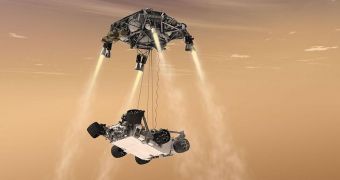Having launched on November 26, 2011, the NASA Mars Science Laboratory (MSL) rover Curiosity is currently halfway to its destination. Current plans call for it to land on Mars on August 5, 2012. Mission controllers say that all parameters aboard the spacecraft are nominal.
Curiosity is still encapsulated in it aeroshell, and will remain in this configuration until after it enters the Martian atmosphere. This process is known among mission experts at the NASA Jet Propulsion Laboratory (JPL), in Pasadena, California, as the “6 minutes of terror.”
This is how long the rover will remain out of contact with Earth, as it descends through the atmosphere around the Red Planet at the steepest angle ever attempted by a NASA mission. Curiosity is also the heaviest rover ever deployed on a planetary exploration mission, weighing just under 1 ton.
Another reason for concern among scientists is the fact that the machine will be deployed via the Sky Crane system. The August landing will represent the first instance when this approach will be used. The Sky Crane uses rocket motors to hover in mid-air, and lowers the rover onto the surface via wires.
Any miscalculations could be fatal to this mission, so scientists will have a few extra concerns besides their usual ones, when MSL begins entering the Martian surface. At this point (April 2), MSL has about 125 days to go until reaching its target.
The spacecraft has already completed two of the six planned course-correction maneuvers. Its course runs for a total of 352 million mile (567 million kilometers), Universe Today reports, and ends at the base of Mount Sharp, inside the Gale Crater.
“It is satisfying to get the second maneuver under our belts and know we are headed in the right direction. The cruise system continues to perform very well,” JPL maneuver systems leader, Erisa Hines, explains.
“The purpose is to put us on a trajectory to the point in the Mars atmosphere where we need to be for a safe and accurate landing,” adds JPL maneuver analyst Mau Wong. Course-correction maneuvers are required because the MSL was purposefully set on the wrong course to begin with.
Experts chose to do this so that the rocket upper stage still attached to the spacecraft could be removed and sent to space without threatening to impact Mars. The stage has not been thoroughly decontaminated, and NASA wants to avoid seeding Mars with Earth-based lifeforms.

 14 DAY TRIAL //
14 DAY TRIAL //